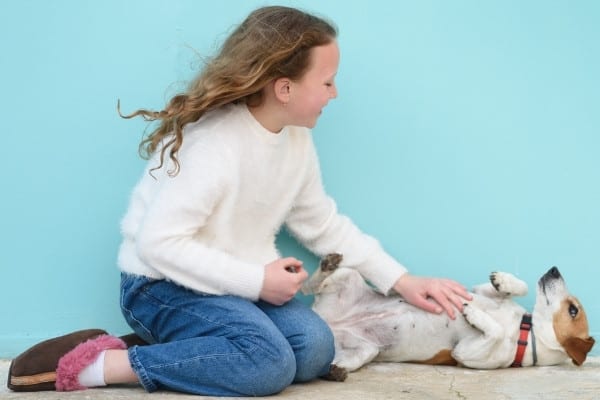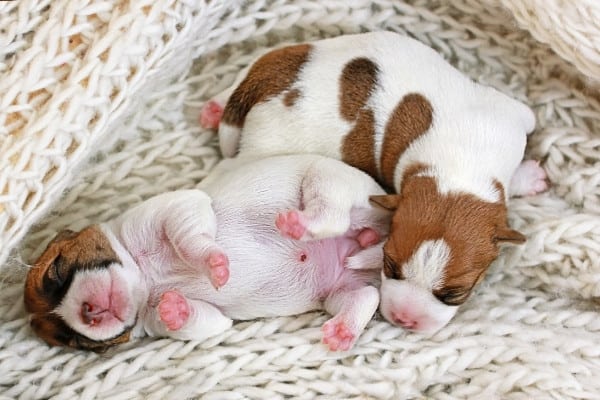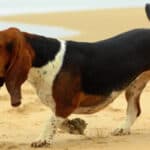
A human’s belly button is pretty distinct, but when it comes to dogs, they can seem nonexistent. If you don’t know where to find it, you might think that your furry friends don’t have belly buttons. But do they?
Do dogs have belly buttons? Dogs do have belly buttons, although they are not as prominent as a human’s belly button. The umbilical cord of a puppy is relatively small in diameter and size, and as the stump heals it shrinks significantly, causing the resulting belly button to be hardly noticeable.
Here’s everything to know about your pooch’s belly and where to look for the belly button the next time you’re giving your furry friend a belly rub.
Dogs and Belly Buttons
Like any placental mammal, dogs have belly buttons, although they might not be as prominent as you’d expect and are often hidden by their fur.
Why Belly Buttons Form in Dogs
Dogs develop belly buttons simply because they are placental mammals.
When they are puppies still developing inside the womb, the umbilical cord serves as a gateway for the mother’s body to send oxygen and nutrients to the puppies.
Once they are born, the residual scar formed after the mother removes the umbilical cord becomes the belly button.
Where a Dog’s Belly Button Is Located
Your furry friend’s belly button scar is easier to spot than you might think. The next time you give your dog a belly rub, look around the middle of the abdomen, toward the end of the rib cage.
Do Dogs Have Visible Belly Buttons?
Usually, a dog’s belly button is noticeable for a short time after they are born, but once the scar heals, it usually just develops into a small wrinkle in the skin that is often covered by their fur.
Once your pet becomes an adult, that residual scar is usually almost imperceptible.
What Does a Dog’s Belly Button Looks Like?
In most dogs, the belly button can look like an oval or circular wrinkle on their skin. Sometimes, it can be a small flat, vertical scar.
You might also notice the fur around their belly button area grows in a swirl or whorl.
Dog Belly Button Hernia
An umbilical hernia in dogs is due to the incomplete closure of their umbilical ring after birth. The hernia usually appears to look like a squishy swelling under the dog’s skin.
Usually, a belly button hernia will look more prominent every time the dog stands, bark, or is crying.
Generally, umbilical hernias in dogs are painless and aren’t a huge area of concern.
However, if it’s bigger than your pinkie finger, there’s a chance that your dog’s intestine may be slipping in and out of the scar.
When that happens frequently, there’s a risk of the intestine sliding out of the hernia opening and getting twisted or trapped.
Small belly button hernias, less than ¼ inches in size, may close spontaneously once the puppy reaches three to four months without needing treatment.
For hernias that don’t close by then, a vet may advise surgery.
Caring for Newborn Puppies’ Belly Buttons

Taking care of the belly button is often a neglected part of a newborn puppy’s overall care regimen but is in no way less important.
In fact, it’s a must-do to avoid having the umbilical cord become infected.
Some tips to remember:
- Be sure to clean the umbilical cord with iodine to prevent infection.
- Gently clean around the base of the stump and its surrounding skin with a cotton swab dipped in warm water. But remember to squeeze out excess water first.
- Use a clean absorbent cloth to dry the area completely. It’s important to keep it clean and dry until the stump falls off naturally and the scar heals.
How Long Does It Take for a Puppy’s Belly Button to Heal?
Generally, the mother dog will bite the puppy’s umbilical cord once the puppy is born.
The stump of the umbilical cord will then dry up and fall off within one to three days, leaving just a faint scar identified as the puppy’s belly button.
Signs of a Puppy Belly Button Infection
If you see any of the following in your puppy’s belly button, it’s a sign that an infection is developing, and it’s imperative to contact your veterinarian immediately.
- Redness and tenderness in the surrounding skin
- Pus draining from the umbilical area
- Umbilical area developing a moist pink bump
- The puppy has a fever
The vet may advise cleaning the infected belly button at home with a moist cloth or cotton swab dipped in alcohol or using an antibiotic cream after you clean the area.
Can a Dog Have an Outie Belly Button?
A dog’s belly button may come in different shapes and sizes, and some can be more noticeable than others, but a dog’s belly button is neither an “innie” nor an “outie.” It is simply a small scar.
Any prominent belly button called an “outie” simply has extra scar tissue.
Related Questions:
Why Do Dogs Have Dewclaws?
Although dewclaws in dogs don’t have a prominent use, they works the same way as the human thumb.
Dewclaws help some dogs grip objects like their toys or bones, but this “extra digit” had a greater purpose for dogs in ancient times as it’s believed that it helped them climb trees to get closer to their prey.
Do All Animals Have Belly Buttons?
Placental mammals have belly buttons, although some are quite unnoticeable or hidden by fur.
Egg-laying mammals like echidna and platypus don’t develop belly buttons as they do not grow in a uterus or have umbilical cords.
Conclusion
If you have a hairy dog, it might be hard to find his belly button. Even with dogs that have light and short coats, belly buttons are often difficult to spot.
It’s a barely visible scar that looks more like a wrinkle in the middle of their abdomen than a human belly button, but it is there!




